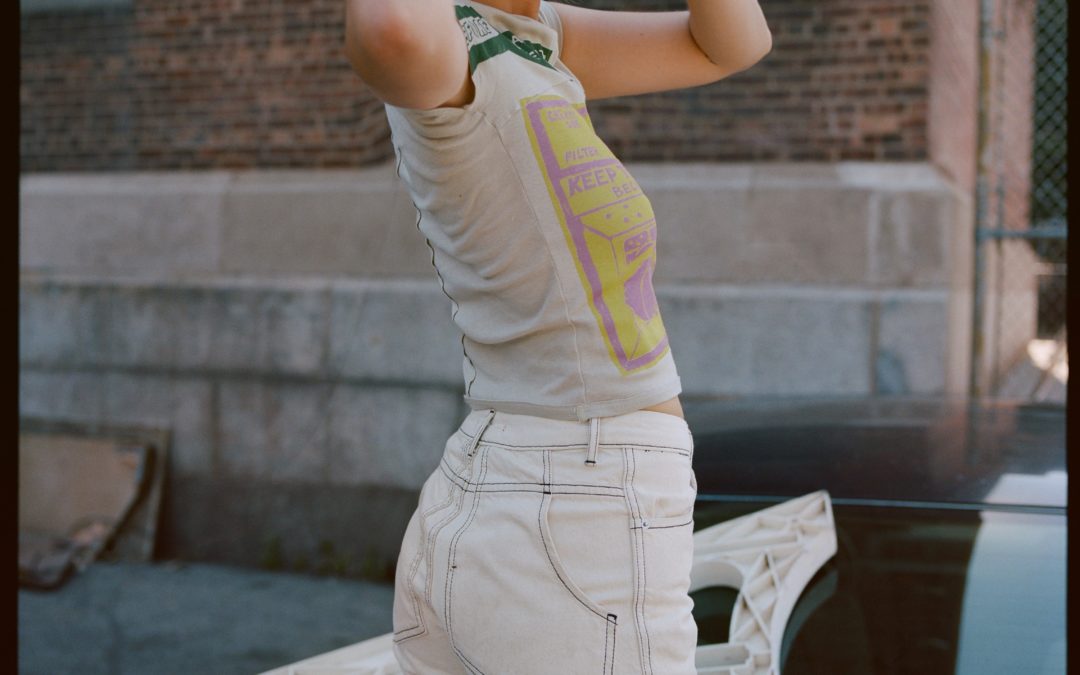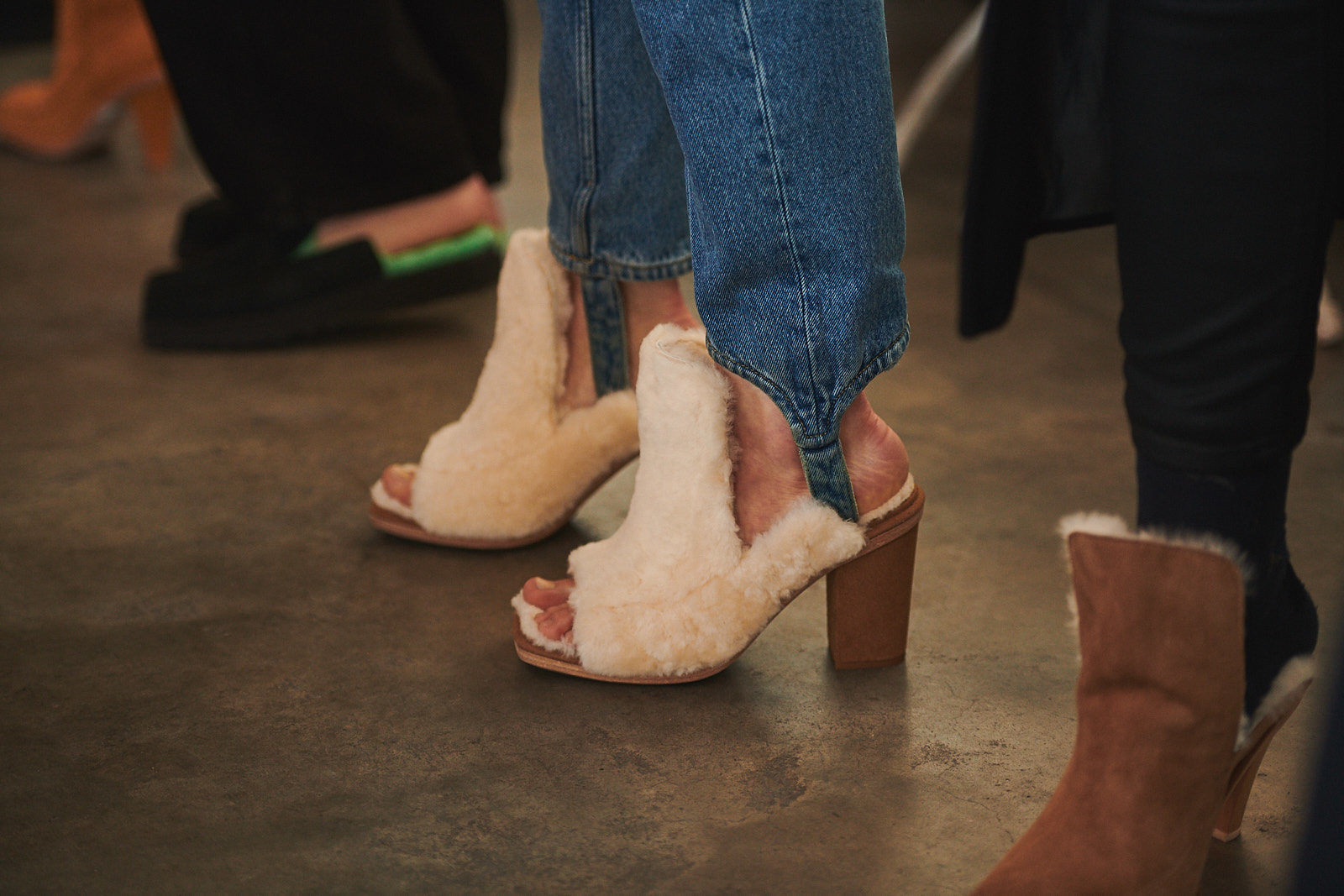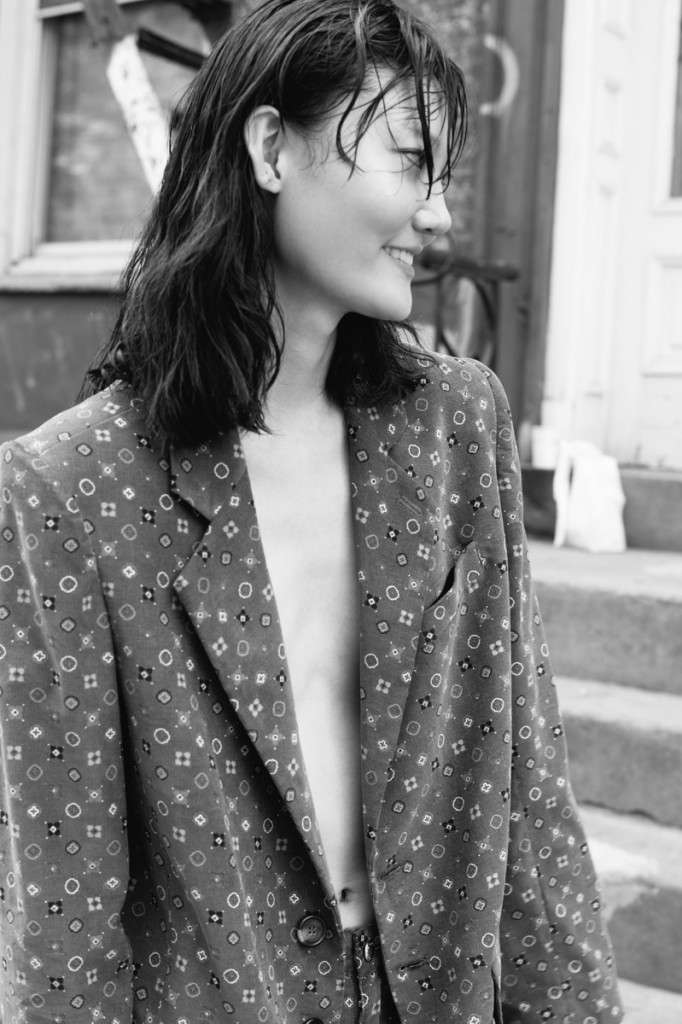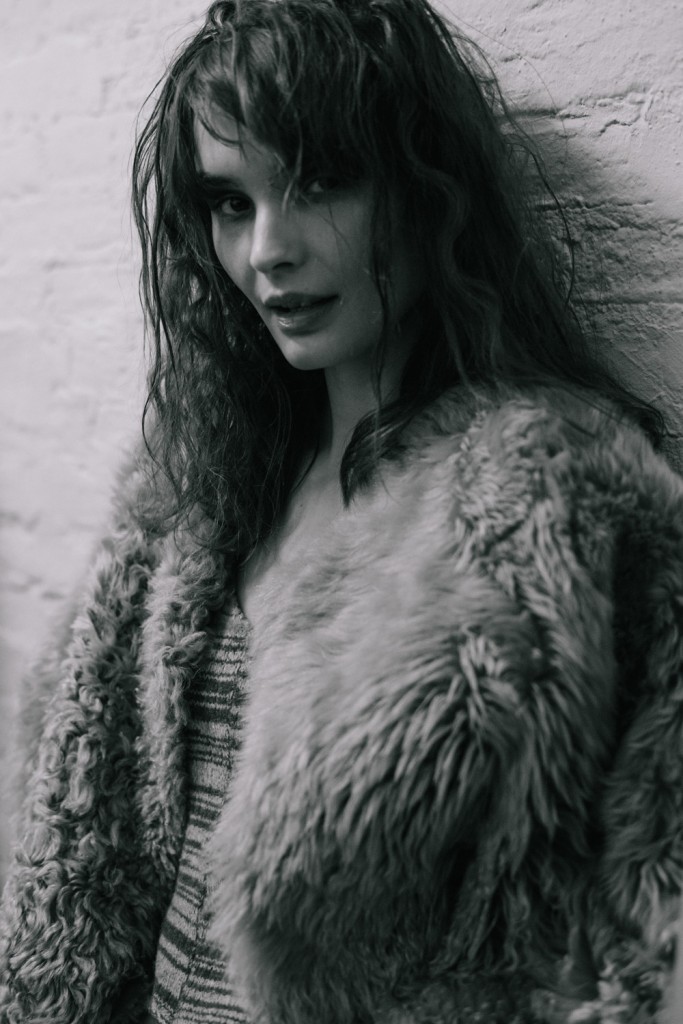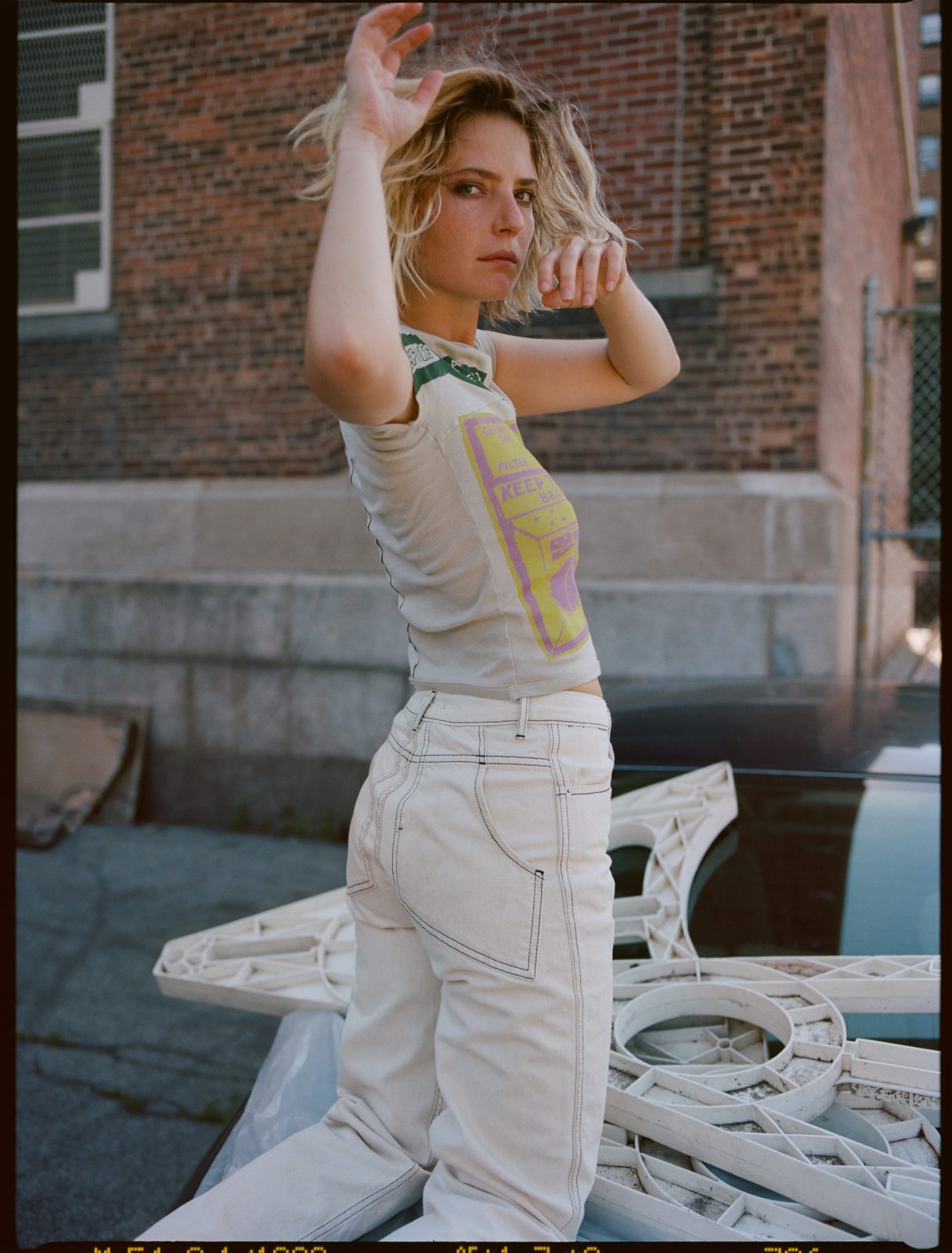
Eckhaus Latta – graphic top, denim pants, boots
A MEETING WITH ECKHAUS LATTA
By Alice Butterlin
A bulwark of New York’s underground scene, Eckhaus Latta is the driving force behind a new vision of fashion. Created in 2012 by Mike Eckhaus and Zoe Latta, two graduates of the Rhode Island School of Design, the brand puts out innovative and wildly creative clothing that blends contemporary art with experimental fashion. Confirmed knitwear junkies, they adapt and deconstruct materials throughout all of their vibrantly colorful collections. Mike and Zoe also speak out strongly in support of queer fashion, diversity and body positivity – positions on full display during their runway shows. At the moment, they also have an exhibition running at the Whitney Museum. Called Possessed, the show contains three parts and showcases the work of fourteen artists associated with Eckhaus Latta. For these passionate fans of contemporary art, life has finally come full circle.
What is the story behind Eckhaus Latta? How did it all start?
Zoe: Mike and I met in college in the Rhode Island School of Design. We became fast friends. None of us were studying fashion design but we both loved fashion, dressing up and playing with clothes. That was kind of the basis of our friendship. Then we graduated and got jobs in the fashion industry. We were living together and we naively decided to have a collection and make a body of work that way. We showed it in February of 2012 and we’ve continued to do so ever since.
Where did your passion for knitwear come from?
Zoe: It’s actually the only structural or institutional education Mike and I received. We both studied knitting while we were in college and that was a tool that we still use today. I was in the textiles department and there were times when Mike and I would sneak in and knit together. It was the first time we had a formal education in making things for the body.
You started out experimenting a lot with different textures and unusual materials. How did you avoid making artworks on hangers?
Mike: We never really thought about it as art, but rather as clothing. That, in itself, allowed it to become clothes rather than art.
Zoe: What we’ve also been interested in is not answering that question. What’s the difference between a t-shirt hanging as a piece of art versus a crazy knit plastic thing? Also, our own experience of wearing crazy plastic knits is not that great. That’s something we’ve become much more tuned into since starting the brand.
Mike: We just grew and matured in our taste. Eckhaus Latta is always parallel to our shifting tastes and things that we become interested in. When you’re twenty-three, your taste is different than when you’re thirty. Eckhaus Latta follows our individual evolution.
Do you feel that not studying fashion helped you see your craft in a different, perhaps more experimental way?
Zoe: Yes, although for us it doesn’t feel experimental because we’re both very intuitive people and we’re making things the way we want to make things. We’re definitely not the kind of people who make a mood board that will drive the whole concept behind the collection. That’s never the way we found working to be pleasurable or exciting. We’re a lot more process-oriented. For us, it’s experimental to try a different jersey on a t-shirt. It comes from the same space as trying a different plastic for an outrageous sweater.
Mike: Totally. You can think of the word experimental as being anything that you haven’t done before. It’ll always feel like an experiment of some sorts, not in the sense of a grandiose gesture. As Zoe says, something as basic as refabricating a t-shirt in a new jersey to see if you like how it is draping, is an experiment. Even more than some XYZ piece that might be in the show that is not about pushing sales but more about pushing concepts.
You mentioned not doing any mood boards, but how do you coordinate both of your visions into one collection?
Zoe: First and foremost, we trust each other a lot. We’re very material-driven and always have an intense process of looking at the materials, finding different things and showing them to each other. We serve as each other’s consultants in a way. We also draw a lot and show each other our sketches. Again, having a critical dialogue around a creative process has been integral to how Mike and I communicate. I think that has been more valuable than if we had studied fashion.
Mike: We bring very different things to the table and we appreciate and question what the other one is doing constantly. There’s a certain rhythm in our way of working. It might be confused at times, but in the end it all comes together.
Eckhaus Latta also conveys the notion of a collective. How important is it to surround yourself with creative people?
Zoe: It’s part of the reason why we felt so compelled to go into fashion, since the industry is so collaborative and requires so many amazing voices. We’re still very excited and fuelled by that. Beyond being each other’s critics, we also have a lot of other people that we talk to about what we’re making and that help us realize things. That part is very appealing to Mike and I.
You seem to take just as keen an interest in the products you make as the visuals that put them in perspective. What did you try to create in terms of brand image?
Zoe: I think a normal fashion company would call those ventures marketing. For us, all of the photo shoots, campaigns and videos came from a desire to collaborate with Alexa Karolinksi or Eric Wrenn, our art director. It’s a way of using the fashion platform to express ideas more so than from a place where we were trying to market ourselves to X customer.
Mike: Yeah, it’s been a long period of back and forth consideration of what was once the desire to make something experimental, for lack of better words, and see other ways of exploring the language of fashion. Progressively, as we grow, we understand the terminology of the language that is marketing and advertising, even though it feels more project-driven.
Your ad campaigns always make a bold statement. You always seem to put a lot of creative energy into those. What ads have influenced you over the years?
Mike: Everything we do takes a deep amount of creative energy. Obviously the ad campaigns are very different than putting together a collection, but you still have that sort of vigor of thought rather than just tossing some clothes on a model and shooting her in front of a seamless white background. There’s a lot of labor in that regard. I don’t think there is any particular fashion campaign that we could nail down to be the driving force. For both of us there’s a plethora of fashion imagery that has been inspiring over the years, whether shot in or before our lifetime.
You are having an exhibition at the Whitney until October 3rd called Possessed. How did that come about?
Mike: We have been in conversation with Chris Lew, who’s been one of the curators there for many years now, about doing a project and it kind of grew from there. It has been an exciting and very intensive, long process. It’s finally going to happen in a couple of weeks. The actual show itself took on many forms and iterations until we found what felt like the most apt mode of exploring what it means for us to have a show at the Whitney and what we feel is compelling to us. Something that makes sense for a fashion brand as well as people who come from a conversation around fine art. The artists exposed are very close to us. At the end of the day, we gravitate more towards our friends’ and peers’ work than others in the industry. Eckhaus Latta has always been a very collaborative space so it felt appropriate to explore that sense of community within the context of this exhibition.
You started your brand in New York. Did the city have a special influence on you and is it welcoming to young designers?
Mike: Yeah. I don’t think we could have started Eckhaus Latta anywhere else. But then again, you only know your life. New York was and is still good to us, but L.A. is also good to us now that we’re here as well.
I remember discovering you on VFiles’ YouTube show Model Files in 2013. What do you think VFiles is doing for young designers?
Mike: At the time, all of our friends were creating the content for it and it was a funny thing to do. We like to work with people we appreciate rather than try to reach out to the unknown. A lot of what we do stems from friendship. Honestly, that Model Files show was so long ago now, I can’t even remember being in it. (laughs)
Zoe: We’re not good at acting, we did not take pleasure in that. (laughs) It was still fun to work with VFiles.
Is it important to work with a casting director who understands your aesthetic?
Zoe: Yeah but it’s also a really natural decision. In the beginning, we didn’t really know how to access models. We were interested in working with our friends and we wanted to see them in our clothes. Now, we have the opportunity to work with a lot more people and it’s still exciting. We like to have a little of both.
Mike: Our castings have never been antagonistic towards a certain sense of beauty. We were more interested in identity and it not being singular. All that still involves industry models but also people that aren’t directly linked to that space.
What do you look for in your models?
Mike: It’s personality above all. You could be the wealthiest person with the access to the best clothes, but still look like an idiot. It’s about someone that’s able to carry clothing well and them feeling confident in themselves. What you’re wearing doesn’t determine if you have good style or not, it all comes down to how you hold yourself in it. That’s really important when we consider casting for people that are not agency models.
You have a new approach to gender in your collections. What is your process of gender-fluid garment-making all about? When do you decide what gender will wear what piece?
Mike: We decide beforehand what things fit a certain gender. But at the end of the day, with styling, some of it goes out the window. Eckhaus Latta is definitely not gender-neutral but I think we are rather gender-curious. It’s something that we question a lot, especially for the past two years since we’ve grown and understood what we’re doing with more clarity.
What is your position regarding the questioning of gender in fashion?
Mike: Certain things are inevitable. Genderless clothing is limited but there are definitely things that can be unisex. We’ve spent a lot of time refining what we consider unisex. It doesn’t necessarily mean that a dress is meant for a woman, besides the fact that we tend to cut dresses with women’s anatomy in mind. It just comes down to physical facts. We spent a lot of time making sure that the denim had a strong fit on both men and women. With core elements of our collections, we’ve made sure there is a unisex language to them. Eckhaus Latta is menswear, it’s womenswear, parts of it are unisex, it’s really just “come as you are, do what you want”. If you like how it looks on you, great.
Another key aspect of your brand is the way you treat nudity and the human body with many sheer pieces and bold cuts. When you send a model half-naked down the runway, is it a subversive act or do you totally desexualize the body?
Zoe: I don’t think we’re desexualizing the body nor are we interested in shocking people. We’re more interested in the idea of normalizing sexuality and seeing beauty in the body. We would never put someone in a sheer look if he or she didn’t feel confident and comfortable in it. Mike and I don’t necessarily wear fully sheer outfits all the time, but what draws us to having this kind of styling is to play with the idea of it. We use it more gesturally than as advice on what people should be wearing every day.
Through your pieces, you’ve also started to redefine what’s considered flattering on women and men.
Mike: I think it’s always better when we don’t try to get too caught up in these things. We work in such an intuitive manner that what we do is a reaction to what we’re seeing as we’re doing fittings, when we’re touching the clothing… At the end of the day, we do want our clothing to flatter people for the most part. We don’t really make things that are about the absence of body, it’s actually really present. We’re speaking to the body instead of not considering it.
Some of your first interns have now created their own fashion brands like Gauntlett Cheng or Vaquera. Do you think you’ve inspired some young designers to make it on their own?
Zoe: We think what they’re doing is great and we’re honored if we inspired them. We’re still close to a lot of them. A lot of them are the same age as us, or a year or two younger. It feels more like a community and it’s nice to see them and hear about what they’re going though. Get advice and give advice. In any case, we don’t feel like their mentors, although we did meet in a context of them working for us.
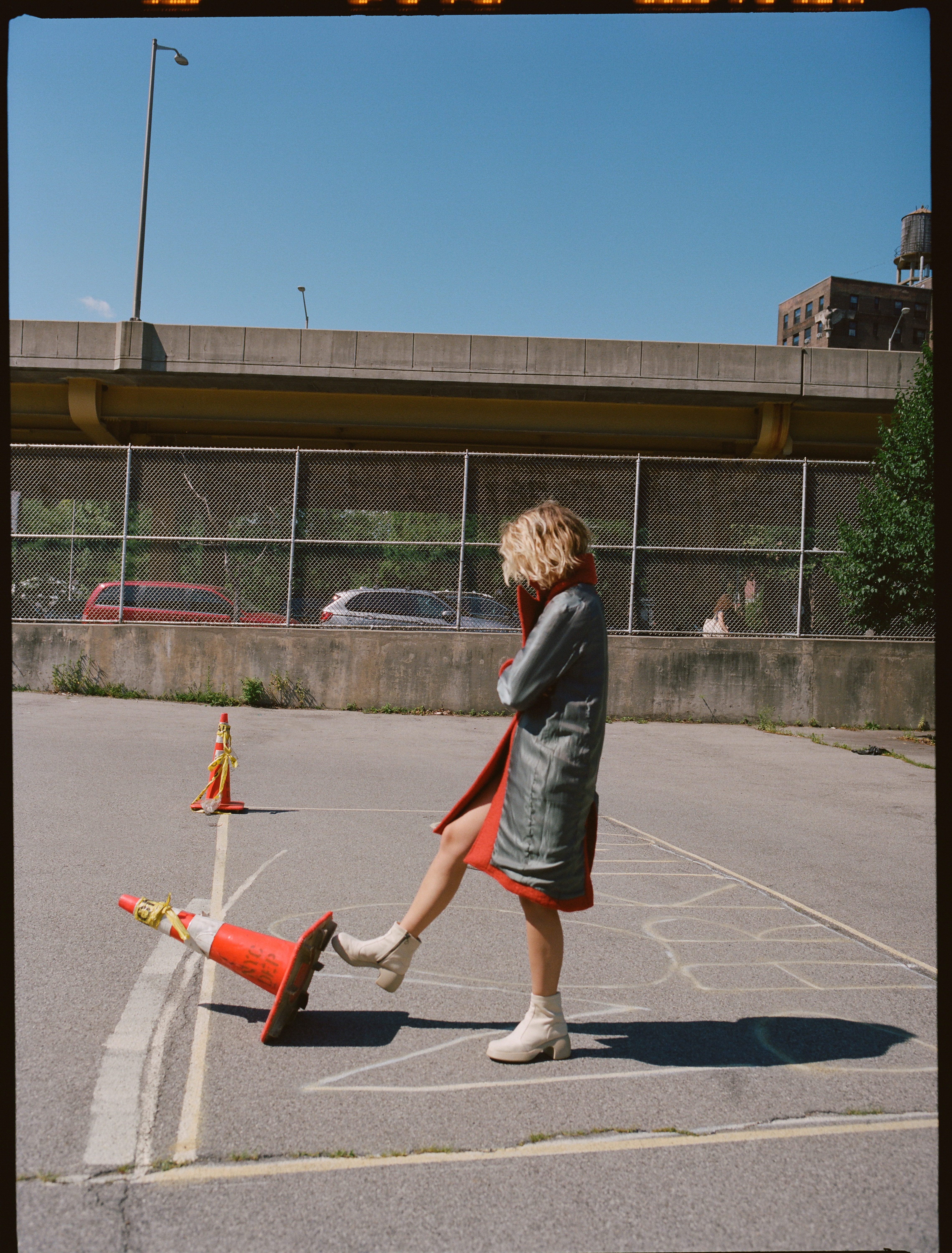
Eckhaus Latta – coat worn inside out, boots

Eckhaus Latta – dress, knitted top
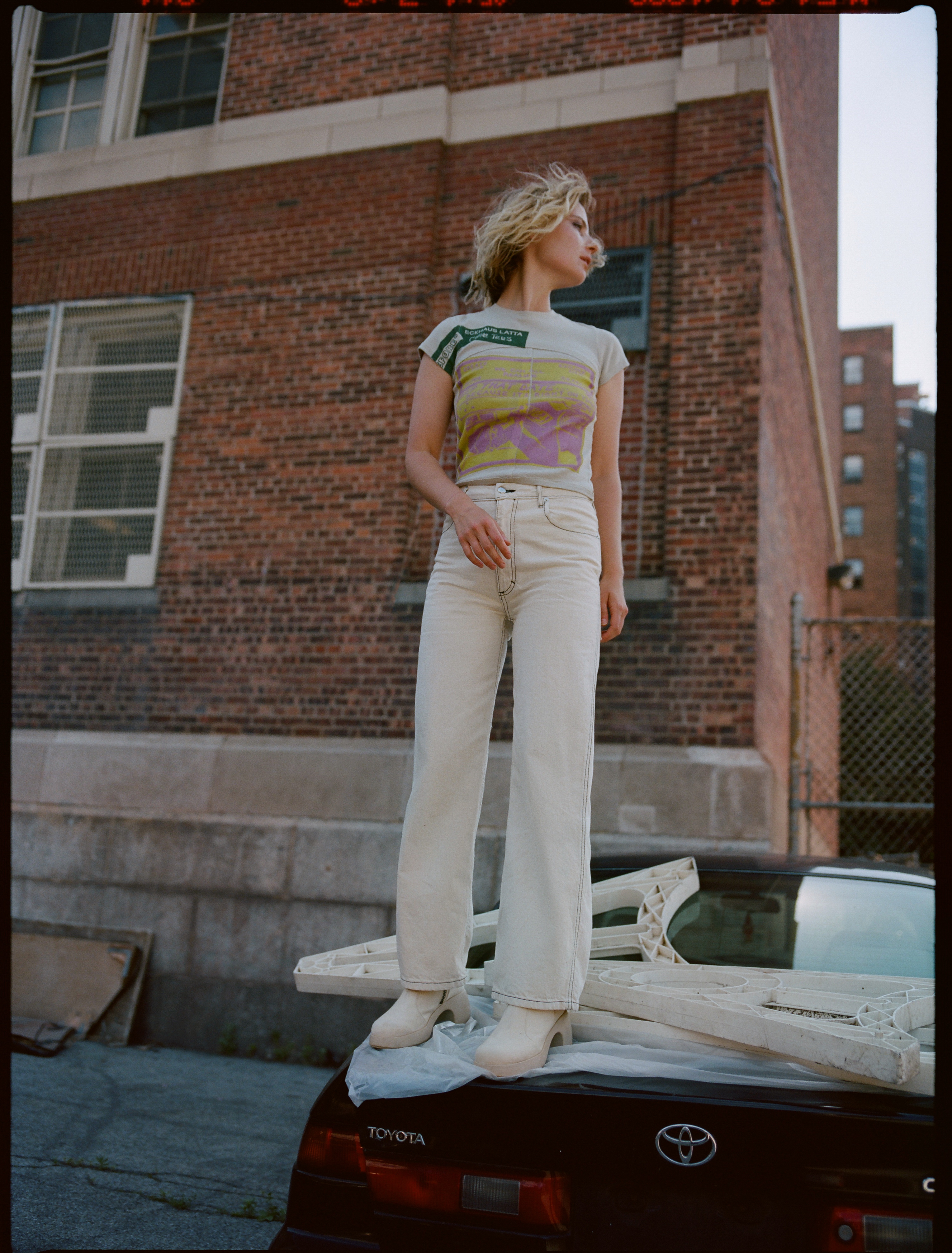
Eckhaus Latta – graphic top, denim pants, boots
***
Photographer: Hans Neumann
Stylist: Melissa Levy
Model: Camilla Deterre
Make-up: Stoj
Hair: Ryan Mitchell
Casting: Felicity Webb







